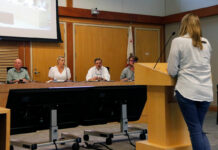— Rollie Atkinson
Who is your doctor? Is he an old “friend” that has been taking
care of you and your family for several generations? Or is she a
younger physician who recently joined the heath care team at your
local community clinic? Maybe your doctor has joined the new model
of primary care practices, by affiliating with other doctors,
practitioners and specialists at one of our local hospitals or
growing health centers.
In any event, if you have a doctor to call your own, you should
feel fortunate enough to take a moment during this time of national
health care reform and related challenges to say “thanks for being
there.”
This week happens to include National Doctor’s Day (March 30), a
day that has been set aside since 1933 to honor family doctors,
alive or passed, for their many positive contributions to both our
health and our communities.
Here in Sonoma County we are indeed fortunate to have such a
great wealth of physicians and health services. Many other
communities, near and far, can not claim the same. While Sonoma
County has almost 40,000 people that have no doctor or regular
health care, the numbers of uninsured and untreated patients is
much higher in almost all other parts of the country.
The local health care industry has faced a series of major
threats over recent times including hospital bankruptcies, cuts to
Medicare and Medi-Cal programs and a shrinking number of insured
patients.
Like just about every other profession, being a doctor and
having a medical practice is not what it used to be. Office costs,
low reimbursements, expensive education and changing technology all
present increased challenges to both primary care physicians and
specialists.
According to the Sonoma County Medical Association, there are
about 460 primary care doctors in the county and a total of 1,050
active physicians. This number has been declining over the last
decade as many doctors have retired and young doctors find Sonoma
County’s cost of living too high to launch a new practice.
Medical school has always been a very expensive and exhaustive
endeavor. Only the most dedicated men and women pursue a life in
medicine and health care. Maybe it was once a lucrative career, but
the economics have changed where the long hours and constant rush
has not.
Young doctors today leave medical school with as much as
$200,000 in tuition debt. Adding the cost of buying a Sonoma County
home, equipping and staffing a medical practice, finding
malpractice insurance and all the rest is changing the face of
today’s family and primary health care system.
“It’s near to impossible to operate as a new private office or
small group,” said Dr. Catherine Gutfreund, a younger family
medicine practitioner who will be president of the Sonoma County
Medical Association this year.
Sonoma County has enjoyed a “collegial” and diversified
physician community for many generations. Many new physicians
continue to be “grown” here through the Santa Rosa Family Medicine
Residency program, first established in the 1930s at the old county
hospital on Chanate Drive. Each year a dozen new family doctors
complete their internships and residency and some always choose to
stay.
“We have the lifestyle, the small towns and the incredibly
strong local clinics and hospitals,” said Dr. Gutfreund who moved
here from Detroit, Michigan to join Kaiser Permanente.
While remembering to give thanks for having a doctor to call
your own, Dr. Gutfreund said everyone should also thank Congress
and the Obama Administration for passing health care reform. She
said more county residents will gain health insurance and access to
regular care under the reforms. She said local doctors and other
health care professionals will be able to increase attention on
women’s, healthy kids and other preventative care programs.
All this and other initiatives like the county’s iWalk and iGrow
self-care programs offer more great reasons to say thanks to our
many great doctors.








